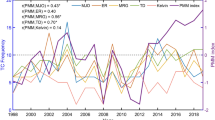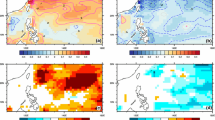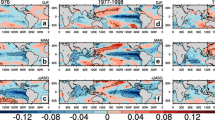Abstract
To understand the impacts of large-scale circulation during the evolution of El Niño cycle on tropical cyclones (TC) is important and useful for TC forecast. Based on best-track data from the Joint Typhoon Warning Center and reanalysis data from National Centers for Environmental Prediction for the period 1975–2014, we investigated the influences of two types of El Niño, the eastern Pacific El Niño (EP-El Niño) and central Pacific El Niño (CP-El Niño), on global TC genesis. We also examined how various environmental factors contribute to these influences using a modified genesis potential index (MGPI). The composites reproduced for two types of El Niño, from their developing to decaying phases, were able to qualitatively replicate observed cyclogenesis in several basins except for the Arabian Sea. Certain factors of MGPI with more influence than others in various regions are identified. Over the western North Pacific, five variables were all important in the two El Niño types during developing summer (July–August–September) and fall (October–November–December), and decaying spring (April–May–June) and summer. In the eastern Pacific, vertical shear and relative vorticity are the crucial factors for the two types of El Niño during developing and decaying summers. In the Atlantic, vertical shear, potential intensity and relative humidity are important for the opposite variation of EP- and CP-El Niños during decaying summers. In the Southern Hemisphere, the five variables have varying contributions to TC genesis variation during peak season (January–February–March) for the two types of El Niño. In the Bay of Bengal, relative vorticity, humidity and omega may be responsible for clearly reduced TC genesis during developing fall for the two types and slightly suppressed TC cyclogenesis during EP-El Niño decaying spring. In the Arabian Sea, the EP-El Niño generates a slightly positive anomaly of TC genesis during developing falls and decaying springs, but the MGPI failed to capture this variation.
Similar content being viewed by others
References
Ashok K, Behera S K, Rao S A, Weng H Y, Yamagata T. 2007. El Niño Modoki and its possible teleconnection. Journal of Geophys ical Res earch, 112 (C11): C11007, http://dx. doi.org/10.1029/2006JC003798.
Basher R E, Zheng X. 1995. Tropical cyclones in the southwest Pacific: spatial patterns and relationships to Southern Oscillation and sea surface temperature. J ournal of Climate, 8 (5): 1249–1260.
Bruyère C L, Holland G J, Towler E. 2012. Investigating the use of a genesis potential index for tropical cyclones in the North Atlantic Basin. J ournal of Climate, 25 (4): 8611–8626.
Camargo S J, Emanuel K A, Sobel A H. 2007. Use of a genesis potential index to diagnose ENSO effects on tropical cyclone genesis. Journal of Climate, 20 (19): 4819–4834.
Camargo S J, Sobel A H. 2005. Western North Pacific tropical cyclone intensity and ENSO. J ournal of Climate, 18 (5): 2996–3006.
Chan J C L. 1995. Tropical cyclone activity in the western North Pacific in relation to the stratospheric quasi-biennial oscillation. Mon thly Wea ther Rev iew, 123 (8): 2567–2571.
Chand S S, Walsh K J E. 2009. Tropical cyclone activity in the Fiji region: spatial patterns and relationship to large-scale circulation. Journal of Climate, 22 (14): 3877–3893.
Chen T C, Wang S Y, Yen M C. 2006. Interannual variation of tropical cyclone activity over the western North Pacific. Journal of Climate, 19 (21): 5709–5720.
Dowdy A J, Qi L X, Jones D, Ramsay H, Fawcett R, Kuleshov Y. 2012. Tropical cyclone climatology of the South Pacific Ocean and its relationship to El Niño-Southern Oscillation. Journal of Climate, 25 (18): 6108–6122.
Du Y, Yang L, Xie S P. 2011. Tropical Indian Ocean influence on Northwest Pacific tropical cyclones in Summer following strong El Niño. J ournal of Climate, 24 (1): 315–322.
Emanuel K A, Nolan D S. 2004. Tropical cyclone activity and global climate. In: Proceedings of the 26th Conference on Hurricanes and Tropical Meteorology. American Meteorological Society, Miami, FL. p.240–241.
Evan A T, Camargo S J. 2011. A climatology of Arabian Sea cyclonic storms. Journal of Climate, 24 (1): 140–158.
Goldenberg S B, Landsea C W, Mestas-Nuñez A M, Gray W M. 2001. The recent increase in Atlantic hurricane activity: causes and implications. Science, 293 (5529): 474–479.
Goldenberg S B, Shapiro L J. 1996. Physical mechanisms for the association of El Niño and West African rainfall with Atlantic major hurricane activity. Journal of Climate, 9 (6): 1169–1187.
Goswami B N, Ajayamohan R S, Xavier P K, Sengupta D. 2003. Clustering of synoptic activity by Indian summer monsoon intraseasonal oscillations. Geophys ical Res earch Lett ers, 30 (8): 1431.
Gray W M, Sheaffer J D. 1991. El Niño and QBO influences on tropical cyclone activity. In: Glantz M H, Katz R W, Nicholls N eds. Teleconnections Linking Worldwide Climate Anomalies. Cambridge University Press, New York. p.257–284.
Gray W M. 1968. Global view of the origin of tropical disturbances and storms. Monthly Weather Review, 96 (10): 669–700.
Gray W M. 1979. Hurricanes: their formation, structure and likely role in the tropical circulation. In: Shaw D B ed. Meteorology over the Tropical Oceans. Royal Meteorological Society, London. p.155–218.
Ho C H, Baik J J, Kim J H, Gong D Y, Sui C H. 2004. Interdecadal changes in summertime typhoon tracks. Journal of Climate, 17 (9): 1767–1776.
Ho C H, Kim J H, Kim H S, Sui C H, Gong D Y. 2005. Possible influence of the Antarctic Oscillation on tropical cyclone activity in the western north Pacific. J ournal of Geophys ical Res earch, 110 (D19): D19104, http://dx.doi. org/10.1029/2005JD005766.
Huang P, Chou C, Huang R H. 2011. Seasonal modulation of tropical intraseasonal oscillations on tropical cyclone geneses in the Western North Pacific. Journal of Climate, 24 (24): 6339–6352.
Jiang X A, Zhao M, Waliser D E. 2012. Modulation of tropical cyclones over the Eastern Pacific by the intraseasonal variability simulated in an AGCM. Journal of Climate, 25 (19): 6524–6538.
Kao H Y, Yu J Y. 2009. Contrasting Eastern-Pacific and Central-Pacific types of ENSO. Journal of Climate, 22 (3): 615–632.
Kim H M, Webster P J, Curry J A. 2009. Impact of shifting patterns of Pacific Ocean warming on North Atlantic tropical cyclones. Science, 325 (5936): 77–80.
Kim H M, Webster P J, Curry J A. 2011. Modulation of north Pacific tropical cyclone activity by three phases of ENSO. Journal of Climate, 24 (6): 1839–1849.
Larson J, Zhou Y P, Higgins R W. 2005. Characteristics of landfalling tropical cyclones in the United States and Mexico: climatology and interannual variability. Journal of Climate, 18 (8): 1247–1262.
Larson S, Lee S K, Wang C Z, Chung E S, Enfield D. 2012. Impacts of non-canonical El Niño patterns on Atlantic hurricane activity. Geophys ical Res earch Lett ers, 39 (4): L14706, http://dx.doi.org/10.1029/2012GL052595.
Lee S K, Wang C Z, Enfield D B. 2010. On the impact of central Pacific warming events on Atlantic tropical storm activity. Geophys ical Res earch Lett ers, 37 (17): L17702, http://dx.doi.org/10.1029/2010GL044459.
Liu K S, Chan J C L. 2012. Interannual variation of Southern Hemisphere tropical cyclone activity and seasonal forecast of tropical cyclone number in the Australian region. International Journal of Climatology, 32 (2): 190–202.
Mahala B, Nayak B K, Mohanty P. 2015. Impacts of ENSO and IOD on tropical cyclone activity in the Bay of Bengal. Nat ural Hazards, 75 (2): 1105–1125.
Murakami H, Wang B, Kitoh A. 2011. Future change of Western North Pacific typhoons: projections by a 20-kmmesh global atmospheric model. Journal of Climate, 24 (4): 1154–1169.
Ng E K W, Chan J C L. 2012. Interannual variations of tropical cyclone activity over the north Indian Ocean. International Journal of Climatology, 32 (6): 819–830.
Ren H L, Jin F F. 2011. Niño indices for two types of ENSO. Geophys ical Res earch Lett ers, 38 (4): L04704, http://dx. doi.org/10.1029/2010GL046031.
Sadhuram Y, Murthy T V R, Somayajulu Y K. 2006. Estimation of tropical cyclone heat potential in the Bay of Bengal and its role in the genesis and intensification of storms. Indian J ournal of Mar ine Sci ences, 35 (2): 132–138.
Shaman J, Esbensen S K, Maloney E D. 2009. The dynamics of the ENSO-Atlantic hurricane teleconnection: ENSOrelated changes to the North African-Asian Jet affect Atlantic basin tropical cyclogenesis. Journal of Climate, 22 (9): 2458–2482.
Singh O P, Ali Khan T M, Rahman M S. 2000. Changes in the frequency of tropical cyclones over the North Indian Ocean. Meteorology and Atmospheric Physics, 75 (1-2): 11–20.
Sumesh K G, Ramesh Kumar M R. 2013. Tropical cyclones over north Indian Ocean during El-Niño Modoki years. Nat ural Hazards, 68 (2): 1057–1074.
Tang B H, Neelin J D. 2004. ENSO Influence on Atlantic hurricanes via tropospheric warming. Geophys ical Res earch Lett ers, 31 (24): L24204, http://dx.doi.org/10. 1029/2004GL021072.
Terry J P. 2007. Tropical Cyclones-Climatology and Impacts in the South Pacific. Springer, New York. 209p.
Thorncroft C, Hodges K. 2001. African easterly wave variability and its relationship to Atlantic tropical cyclone activity. Journal of Climate, 14: 1166–1179.
Vincent E M, Lengaigne M, Menkes C E, Jourdain N C, Marchesiello P, Madec G. 2011. Interannual variability of the South Pacific convergence zone and implications for tropical cyclone genesis. Climate Dyn amics, 36 (9-10): 1881–1896, http://dx.doi.org/10.1007/s00382-009-0716-3.
Wang B, Chan J C L. 2002. How strong ENSO events affect tropical storm activity over the western North Pacific. Journal of Climate, 15 (13): 1643–1658.
Wang B, Yang Y X, Ding Q H, Murakami H, Huang F. 2010. Climate control of the global tropical storm days (1965-2008). Geophys ical Res earch Lett ers, 37 (7): L07704, http://dx.doi.org/10.1029/2010GL042487.
Wang C Z, Li C X, Mu M, Duan W S. 2013. Seasonal modulations of different impacts of two types of ENSO events on tropical cyclone activity in the western North Pacific. Clim ate Dyn amics, 40 (11-12): 2887–2902.
Wu G X, Lau N C. 1992. A GCM simulation of the relationship between tropical-storm formation and ENSO. Mon thly Wea ther Review, 120 (6): 958–977.
Xu S B, Huang F. 2015. Impacts of the two types of El Niño on Pacific tropical cyclone activity. Journal of Ocean University of China, 14 (2): 191–198.
Yang L, Wang X, Huang K, Wang D. 2015a. The anomalous tropical cyclone activity in the northwestern Pacific. In: Explaining Extremes of 2014 from a Climate Perspective. Bulletin of the American Meteorological Society, 96(12), S120–S125. http://dx.doi.org/10.1175/BAMS-D-15-00125.1.
Yang L, Du Y, Wang D, Wang C, Wang X. 2015b. Impact of intraseasonal oscillation on the tropical cyclone track in the South China Sea. Climate Dynamics, 44: 1505–1519. http://dx.doi.org/10.1007/s00382-014-2180-y.
Yang Y X, Xie R H, Wang F M, Huang F. 2015c. Impacts of decaying eastern and central Pacific El Niños on tropical cyclone activities over the western North Pacific in summer. Theoretical and Applied Climatology, published OnlineFirst, May 2015, http://dx.doi.org/10.1007/s00704-015-1471-5.
Author information
Authors and Affiliations
Corresponding author
Additional information
Supported by the National Basic Research Program of China (973 Program) (No. 2012CB417402), the State Key Laboratory of Tropical Oceanography, South China Sea Institute of Oceanology, Chinese Academy of Sciences (No. LTO1510), the Strategic Priority Research Program of Chinese Academy of Sciences (No. XDA11010102), the National Natural Science Foundation of China (No. 41106018), the Funds for Creative Research Groups of China (No. 41421005), and the NSFC-Shandong Joint Fund for Marine Science Research Centers (No. U1406401)
Rights and permissions
About this article
Cite this article
Yang, Y., Yang, L. & Wang, F. Analyzing the influences of two types of El Niño on tropical cyclone genesis with a modified genesis potential index. Chin. J. Ocean. Limnol. 35, 452–465 (2017). https://doi.org/10.1007/s00343-016-5295-7
Received:
Accepted:
Published:
Issue Date:
DOI: https://doi.org/10.1007/s00343-016-5295-7




